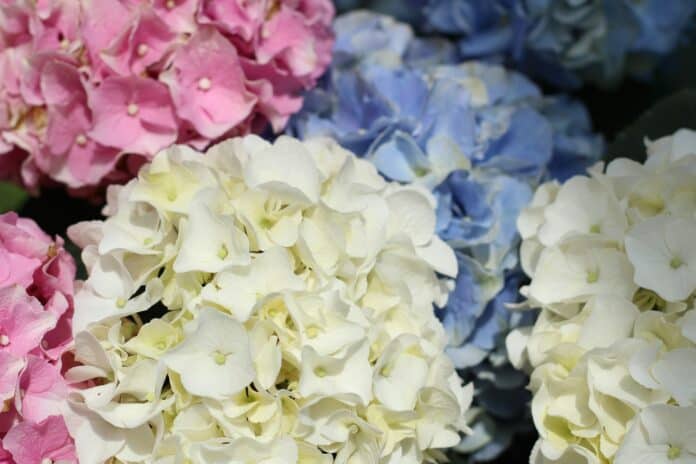
Yewhort is reader-supported. When you buy through links on our site, we may earn an affiliate commission.
Hydrangeas are a garden favorite, celebrated for their stunning blooms and versatility. With so many varieties available, selecting the right hydrangea for your garden can be both exciting and challenging. This guide will help you navigate through the different types of hydrangeas, their growing requirements, and how to ensure they thrive in your garden.
1. Understanding Hydrangea Varieties
Hydrangeas come in various species, each with unique characteristics and growing needs. The most popular types include:
a. Bigleaf Hydrangea (Hydrangea macrophylla)
- Appearance: Known for their large, rounded flower heads, which can be either mophead or lacecap types.
- Color: Flower color can vary from pink to blue, depending on soil pH.
- Growing Conditions: Prefers partial shade and well-drained soil.
- Hardiness: Zones 6-9.
b. Panicle Hydrangea (Hydrangea paniculata)
- Appearance: Features cone-shaped flower clusters that start white and age to pink or even red.
- Color: Primarily white, transitioning to pink/red.
- Growing Conditions: Thrives in full sun to partial shade and is quite hardy.
- Hardiness: Zones 3-8.
c. Smooth Hydrangea (Hydrangea arborescens)
- Appearance: Rounded flower clusters, often in white.
- Color: Mostly white, with some cultivars offering light pink.
- Growing Conditions: Adaptable to different soil types and can tolerate more sun.
- Hardiness: Zones 3-9.
d. Oakleaf Hydrangea (Hydrangea quercifolia)
- Appearance: Distinctive oak-shaped leaves and conical flower heads.
- Color: White flowers turning pinkish-purple as they age.
- Growing Conditions: Prefers partial shade and well-drained soil.
- Hardiness: Zones 5-9.
e. Mountain Hydrangea (Hydrangea serrata)
- Appearance: Smaller, lacecap flowers, similar to Bigleaf Hydrangeas.
- Color: Varies with soil pH.
- Growing Conditions: Prefers cooler climates and partial shade.
- Hardiness: Zones 5-9.
2. Factors to Consider When Choosing Hydrangeas
a. Climate and Hardiness Zone
- Ensure the hydrangea variety you choose is suitable for your USDA hardiness zone.
b. Sunlight Requirements
- Some hydrangeas thrive in full sun, while others prefer partial to full shade.
c. Soil Type and pH
- Soil pH can affect flower color in some hydrangeas (e.g., Bigleaf and Mountain hydrangeas). Acidic soil (pH below 6) tends to produce blue flowers, while alkaline soil (pH above 7) produces pink flowers.
d. Space and Size
- Consider the mature size of the hydrangea and ensure you have enough space for it to grow.
3. Planting and Care Tips
a. Planting
- Timing: Plant hydrangeas in spring or fall.
- Location: Choose a location with the appropriate amount of sunlight and well-drained soil.
- Planting Hole: Dig a hole twice as wide as the root ball and as deep as the plant’s container.
b. Watering
- Hydrangeas need regular watering, especially in the first year after planting. Ensure the soil remains consistently moist but not waterlogged.
c. Mulching
- Apply mulch around the base of the plant to retain moisture, regulate soil temperature, and suppress weeds.
d. Pruning
- Pruning needs vary by species. For instance, Bigleaf hydrangeas bloom on old wood and should be pruned after flowering, while Panicle hydrangeas bloom on new wood and can be pruned in late winter or early spring.
e. Fertilizing
- Use a balanced, slow-release fertilizer in spring. Avoid high-nitrogen fertilizers as they can promote leafy growth at the expense of flowers.
4. Common Problems and Solutions
a. Wilting
- Ensure consistent watering, especially during hot, dry spells. Check for proper drainage to prevent root rot.
b. Leaf Spot and Mildew
- Provide good air circulation by spacing plants appropriately and pruning to remove crowded branches. Use fungicides if necessary.
c. Pests
- Watch for aphids, spider mites, and scale. Use insecticidal soap or horticultural oil to manage infestations.
5. Popular Hydrangea Cultivars
a. Bigleaf Hydrangea
- ‘Endless Summer’: A reblooming variety with blue or pink flowers.
- ‘Nikko Blue’: Renowned for its vibrant blue blooms in acidic soil.
b. Panicle Hydrangea
- ‘Limelight’: Known for its large, lime-green flowers that turn pink in fall.
- ‘Quick Fire’: Early blooming with flowers that transition from white to deep pink.
c. Smooth Hydrangea
- ‘Annabelle’: Large, white flower heads, reliable and hardy.
- ‘Incrediball’: Notable for its massive, round blooms.
d. Oakleaf Hydrangea
- ‘Snow Queen’: Large, white flower clusters that age to pink.
- ‘Ruby Slippers’: Compact variety with flowers that turn deep pink.
Conclusion
Choosing the right hydrangea for your garden involves understanding the different species, their specific growing requirements, and how they will fit into your garden’s design. By considering your local climate, soil conditions, and the amount of sunlight your garden receives, you can select a hydrangea variety that will thrive and bring beauty to your outdoor space for years to come. Happy gardening!






